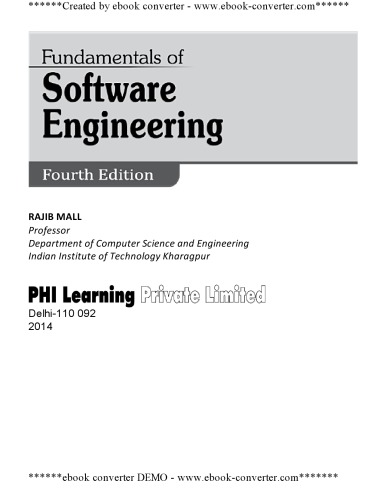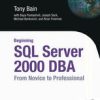Fundamentals of software engineering 4th Edition by Rajib Mall ISBN B00LPGBVTM
$50.00 Original price was: $50.00.$35.00Current price is: $35.00.
Fundamentals of software engineering 4th Edition by Rajib Mall – Ebook PDF Instant Download/Delivery: B00LPGBVTM
Full download Fundamentals of software engineering 4th Edition after payment
Product details:
ISBN 10: B00LPGBVTM
ISBN 13:
Author: Rajib Mall
Advancements and rapid developments have led to many ramifications in the ever-changing world of software engineering. This book, in its Fourth Edition, is restructured and extensively revised to trace the advancements made and landmarks achieved in the field. This book not only incorporates latest and enhanced software engineering techniques and practices but also shows how these techniques are applied into the practical software assignments. The chapters are incorporated with illustrative examples to add an analytical insight on the subject. The book is logically organised to cover expanded and revised treatment of all software process activities.
Fundamentals of software engineering 4th Edition Table of contents:
Part I: Introduction to Software Engineering
Chapter 1: Introduction to Software Engineering
- What is Software Engineering?
- Software Development Life Cycle (SDLC)
- Key Concepts in Software Engineering
- Challenges in Software Engineering
- Roles of Software Engineers
Chapter 2: Software Development Models
- Waterfall Model
- V-Model
- Iterative and Incremental Models
- Agile and Scrum Methodologies
- Comparison of Software Development Models
Chapter 3: Software Requirements Engineering
- Importance of Requirements Engineering
- Types of Software Requirements
- Requirements Elicitation and Gathering
- Analyzing and Documenting Requirements
- Requirements Specification Techniques
- Validating and Verifying Requirements
Part II: Software Design
Chapter 4: Software Design Fundamentals
- The Role of Design in Software Engineering
- Characteristics of Good Software Design
- Design Principles: Modularity, Cohesion, and Coupling
- Overview of Design Patterns
- Design Notations and Tools
Chapter 5: Architectural Design
- Software Architecture and Its Importance
- Layered Architecture and Client-Server Models
- Architectural Styles and Patterns
- Design for Scalability and Performance
- Documenting and Communicating Architecture
Chapter 6: Detailed Design
- Transitioning from High-Level to Low-Level Design
- Interface Design and Interaction Diagrams
- Data Design and Database Design Techniques
- Design Refinement and Validation
- UML (Unified Modeling Language) for Design
Part III: Software Construction and Implementation
Chapter 7: Coding and Implementation
- Best Practices in Coding
- Code Reviews and Refactoring
- Choosing the Right Programming Languages
- Implementing Software Design in Code
- Debugging and Testing During Implementation
- Version Control Systems and Tools
Chapter 8: Software Testing
- The Importance of Testing in Software Development
- Types of Testing: Unit Testing, Integration Testing, System Testing, and Acceptance Testing
- Testing Strategies and Techniques
- Test Automation and Frameworks
- Performance, Load, and Stress Testing
- Bug Tracking and Defect Management
Part IV: Software Maintenance
Chapter 9: Software Maintenance and Evolution
- The Role of Maintenance in Software Engineering
- Types of Maintenance: Corrective, Adaptive, and Perfective
- Maintenance Processes and Techniques
- Managing Change in Software Systems
- Software Evolution and Legacy Systems
- Configuration Management
Part V: Software Project Management
Chapter 10: Software Project Management Fundamentals
- The Role of Project Management in Software Engineering
- Project Planning and Scheduling
- Estimation Techniques: Function Points, LOC, COCOMO
- Risk Management in Software Projects
- Managing Software Development Teams
- Budgeting, Cost Estimation, and Resource Allocation
Chapter 11: Quality Assurance and Process Improvement
- Software Quality and Quality Assurance Techniques
- Software Metrics: Defect Density, Code Coverage, etc.
- Process Models for Software Development: CMMI, ISO 9000
- Continuous Improvement Practices
- The Role of Audits and Reviews
Part VI: Software Engineering Tools and Emerging Topics
Chapter 12: Software Engineering Tools
- Integrated Development Environments (IDEs)
- Configuration Management Tools
- Testing Tools and Test Automation
- Project Management Software
- Continuous Integration and Deployment Tools
Chapter 13: Emerging Trends in Software Engineering
- Cloud Computing and Software Engineering
- Software Engineering for Mobile Applications
- Big Data, AI, and Software Engineering
- DevOps Practices and Automation
- Software Engineering for Cybersecurity
- Ethical and Social Issues in Software Engineering
Part VII: Case Studies and Applications
Chapter 14: Case Studies in Software Engineering
- Case Study 1: Developing an E-Commerce System
- Case Study 2: Building a Mobile App
- Case Study 3: Software for Financial Systems
- Lessons Learned from Real-World Projects
Chapter 15: Industry Practices and Professionalism
- Professional Responsibilities of Software Engineers
- Software Engineering Ethics and Codes of Conduct
- Certification and Continuing Education
- Working in the Software Industry: Career Paths and Opportunities
Appendices
- A: Glossary of Key Terms in Software Engineering
- B: Key Software Engineering Standards and References
- C: Further Reading and Resources
- D: Answers to Practice Questions
People also search for Fundamentals of software engineering 4th Edition:
rajib mall fundamentals of software engineering 5th edition pdf
rajib mall fundamentals of software engineering solutions
mandrioli fundamentals of software engineering 2e
mandrioli fundamentals of software engineering 2e
Tags:
Rajib Mall,Fundamentals,software engineering



